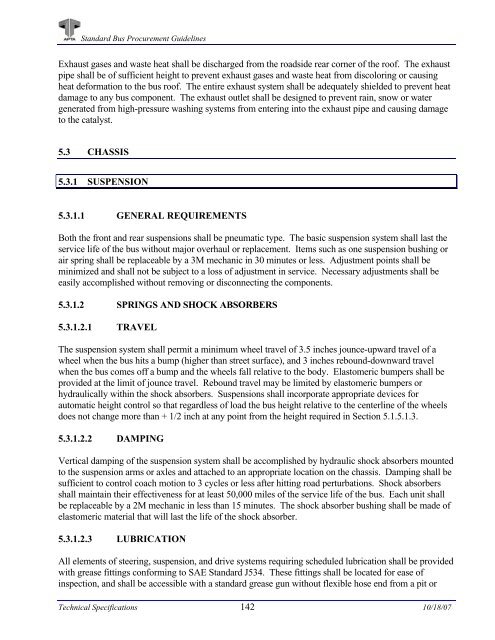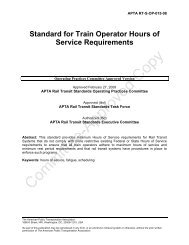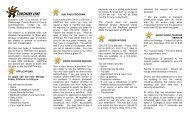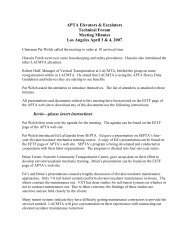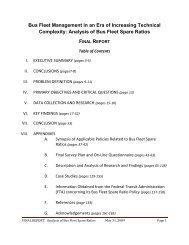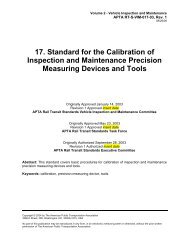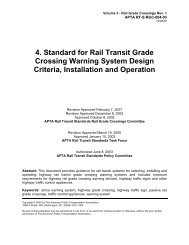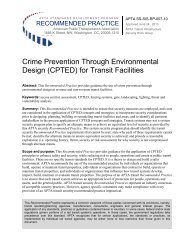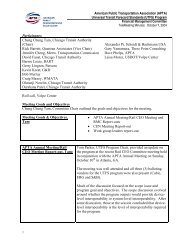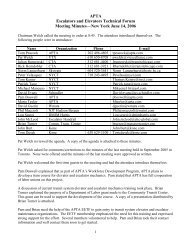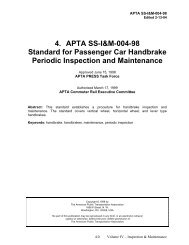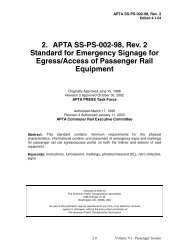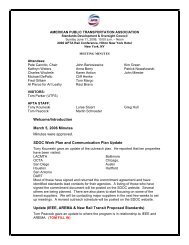Standard Bus Procurement Guidelines - APTAStandards.com
Standard Bus Procurement Guidelines - APTAStandards.com
Standard Bus Procurement Guidelines - APTAStandards.com
You also want an ePaper? Increase the reach of your titles
YUMPU automatically turns print PDFs into web optimized ePapers that Google loves.
<strong>Standard</strong> <strong>Bus</strong> <strong>Procurement</strong> <strong>Guidelines</strong><br />
Exhaust gases and waste heat shall be discharged from the roadside rear corner of the roof. The exhaust<br />
pipe shall be of sufficient height to prevent exhaust gases and waste heat from discoloring or causing<br />
heat deformation to the bus roof. The entire exhaust system shall be adequately shielded to prevent heat<br />
damage to any bus <strong>com</strong>ponent. The exhaust outlet shall be designed to prevent rain, snow or water<br />
generated from high-pressure washing systems from entering into the exhaust pipe and causing damage<br />
to the catalyst.<br />
5.3 CHASSIS<br />
5.3.1 SUSPENSION<br />
5.3.1.1 GENERAL REQUIREMENTS<br />
Both the front and rear suspensions shall be pneumatic type. The basic suspension system shall last the<br />
service life of the bus without major overhaul or replacement. Items such as one suspension bushing or<br />
air spring shall be replaceable by a 3M mechanic in 30 minutes or less. Adjustment points shall be<br />
minimized and shall not be subject to a loss of adjustment in service. Necessary adjustments shall be<br />
easily ac<strong>com</strong>plished without removing or disconnecting the <strong>com</strong>ponents.<br />
5.3.1.2 SPRINGS AND SHOCK ABSORBERS<br />
5.3.1.2.1 TRAVEL<br />
The suspension system shall permit a minimum wheel travel of 3.5 inches jounce-upward travel of a<br />
wheel when the bus hits a bump (higher than street surface), and 3 inches rebound-downward travel<br />
when the bus <strong>com</strong>es off a bump and the wheels fall relative to the body. Elastomeric bumpers shall be<br />
provided at the limit of jounce travel. Rebound travel may be limited by elastomeric bumpers or<br />
hydraulically within the shock absorbers. Suspensions shall incorporate appropriate devices for<br />
automatic height control so that regardless of load the bus height relative to the centerline of the wheels<br />
does not change more than + 1/2 inch at any point from the height required in Section 5.1.5.1.3.<br />
5.3.1.2.2 DAMPING<br />
Vertical damping of the suspension system shall be ac<strong>com</strong>plished by hydraulic shock absorbers mounted<br />
to the suspension arms or axles and attached to an appropriate location on the chassis. Damping shall be<br />
sufficient to control coach motion to 3 cycles or less after hitting road perturbations. Shock absorbers<br />
shall maintain their effectiveness for at least 50,000 miles of the service life of the bus. Each unit shall<br />
be replaceable by a 2M mechanic in less than 15 minutes. The shock absorber bushing shall be made of<br />
elastomeric material that will last the life of the shock absorber.<br />
5.3.1.2.3 LUBRICATION<br />
All elements of steering, suspension, and drive systems requiring scheduled lubrication shall be provided<br />
with grease fittings conforming to SAE <strong>Standard</strong> J534. These fittings shall be located for ease of<br />
inspection, and shall be accessible with a standard grease gun without flexible hose end from a pit or<br />
Technical Specifications 142 10/18/07


